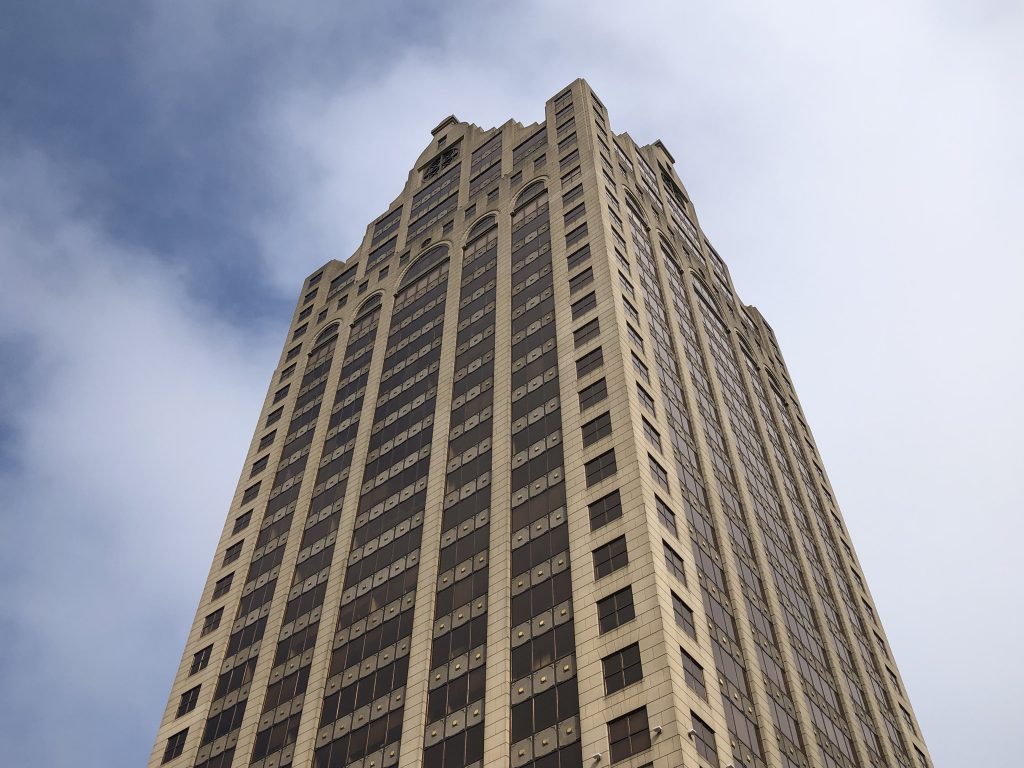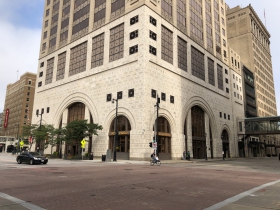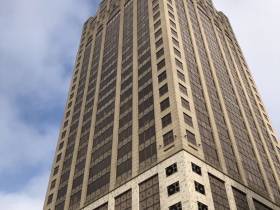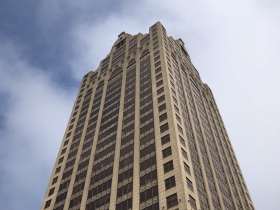Downtown Tower Could Be Redeveloped With Historic Tax Credits
Can the Postmodern 100 East tower, built in 1989, qualify for historic designation?
Can something from 1989 be considered historic? We’re about to find out.
The developers who purchased the 35-story 100 East office building out of foreclosure are seeking to convert the tower into the state’s tallest apartment building.
To finance the conversion, they’re seeking historic preservation tax credits from the state and federal governments. But to access credits, which offset up to 40% of historically-sensitive repairs or alterations, the building needs to be listed on the National Register of Historic Places. The city’s Historic Preservation Commission (HPC) did its part Monday, voting to recommend the National Park Service recognize the building.
“Generally speaking, buildings need to be 50 years old to be placed on the National Register,” said HPC planner Andrew Stern during the commission’s Monday meeting. “They’re making an argument as the most important Postmodern building in the city of Milwaukee it deserves special consideration.”
“This is not the first building of roughly this age or Postmodern style to be listed early. It’s just the first in Wisconsin,” said HPC planner Tim Askin.
The style, which dates back to the 1950s, flourished in the 1980s and 1990s as a response to modern architecture’s austere nature. The defining features of 100 East, said Stern, are its coursed limestone cladding, symmetrical design, unpainted facade, shaped parapets, bronze spandrel panels and cupola.
The building’s design was intended to pay homage to the previous office tower on the site: the Pabst Building. The structure was constructed in the 1890s in the German Renaissance Revival style. But after being stripped of much of its ornamentation, it was demolished in 1981.
“Likely the most important Postmodern architectural specimen in the city of Milwaukee,” said Stern in summarizing the argument from Kansas City-based preservation consultant Rosin Preservation.
“I think it’s hard to argue against that,” said Stern, noting its visibility and design. It is the third-tallest building in Wisconsin and sits on a prominent site along Wisconsin Avenue between N. Water Street and the Milwaukee River.
A partnership of developers Johnny Vassallo, Joe Klein and Klein Development purchased the mostly vacant building out of foreclosure last August for $29 million. Once the remaining tenants, including Gruber Law Offices and Marcus Corp., relocate from the 435,437-square-foot building, it could become approximately 350 apartments.
“If they can get this through the National Park Service, more power to them,” said Commissioner and area alderman Robert Bauman in support of the designation.
He said he expected the development team to also seek a tax incremental financing subsidy to support affordable housing in a portion of the building.
“I think it would be great for the city to have apartments, whether they’re luxury or otherwise, versus an empty office building,” said Commissioner Jordan Morales.
Ann Pieper Eisenbrown was the lone objection to supporting the nomination.
The tower was designed by the Charlotte-based firm of Clark, Tribble, Harris & Li. It was developed by national firm Faison Associates as a speculative office building. It changed hands several times in recent years before entering foreclosure.
A similar process played out in 2021 with the former M&I Bank building (now known as 770 North) a block to the north. But Askin said the Internal Revenue Service ultimately blocked the use of preservation tax credits on the International Style tower from 1968 because Irgens had demolished the attached parking structure, viewed as a contributing component, to create the site for BMO Tower. Irgens has recently reactivated plans to redevelop the M&I building into a mix of housing, offices or a hotel.
A copy of the 100 East nomination form, a compendium of the building’s history, is available on Urban Milwaukee.
Photos
Legislation Link - Urban Milwaukee members see direct links to legislation mentioned in this article. Join today
Existing members must be signed in to see the interactive map. Sign in.
If you think stories like this are important, become a member of Urban Milwaukee and help support real, independent journalism. Plus you get some cool added benefits.
Political Contributions Tracker
Displaying political contributions between people mentioned in this story. Learn more.
- March 23, 2017 - Robert Bauman received $50 from Ann Pieper Eisenbrown
- September 4, 2014 - Robert Bauman received $50 from Ann Pieper Eisenbrown























The late Whitney Gould hated this building and derided it, rightly, as a derivative knockoff – faux historicism. I think this application is a pretty big stretch. That said, it would be great if the developers can successfully convert the building to housing.
@David Coles…thanks for mentioning this! I’ve been looking online this morning for The Milwaukee Journal article critical of 100 East but could not find it. I must be remembering what Gould wrote about it! I remember one of the criticisms was that the detailing was rather flat which, compared to the Pabst Building, it was. I don’t think it is something that would go unnoticed in the City approval process, today.
Between when the Pabst Building was demolished in 1981 and construction started on 100 East in 1987, there were plans for “River Place” at the site (I remember being excited by the rendering: modern and angular) and then a makeshift park when those plans fell through.
Ack…to imagine something younger that me being deemed historic… :-/ All in all, I do think 100 East and Milwaukee’s other post-modern towers–Associated Bank River Center (Milwaukee Center) and 1000 North Water Street hold up rather well. I get that people want larger windows but, fer cripes…does everything have to be glass these days?
Also two things:
– What’s up with so many broken citation links at the bottom of Wikipedia articles?
– The Milwaukee Public Library’s “Ready Reference” still exists! I remember calling it for a bit of information I would need for school papers I would write last minute. So great to have a librarian on call to look something up for you! (Now, you can email or text in addition to calling. 🙂
I hope this all gets turned down. This 80/90s fake “post modern” building is a joke. All they’re trying to is buy a cheap-unwanted building and then get a huge discount on doing the work. What a load.
If projects cannot pay for itself, why should the government (or taxpayers) subsidize them? And this building is about as historic as my big toe. Just another way of giving corporate welfare
Try as I might—and with the assistance of both Google and Microsoft AI products and flipping through spreadsheets—I’ve not been able to find a reliable list of buildings that were named to the National Registry of Historic Places before age 50 years.
However, I did come across this a great article that argues against the 50-year rule (most buildings are renovated or remodeled before then is part of it), while also acknowledging the validity of “age-value.” Read it!
I found most valuable this distinction:
“ A century ago Alois Reigl defined several reasons for saving historic sites, including ‘age value,’ ‘historical value,’ ‘art value,’ and ‘use-value,’ For Reigl, ‘age-value’ and ‘historical value’ were about the past, while ‘art value’ and ‘use-value’ were about the present and future.”
https://vincemichael.wordpress.com/2010/08/13/age-value-and-the-50-year-rule/
Maybe it would be easier to imagine providing landmark status for under 50yo buildings if we took “Historic” out of the name and simply called it “National Landmark Registry.” Food for thought!
Detroit has a large downtown building that looks very similar to 100 E Wisconsin. Does anybody know which one went up first (or anything else about the one across the Lake)?
@TransitRider, Ally Detroit Center, formerly One Detroit Center? That was done in 1993, but it was done by two architects of actual known provenance / previous works / history.
100 East doesn’t have that type of famous backing.